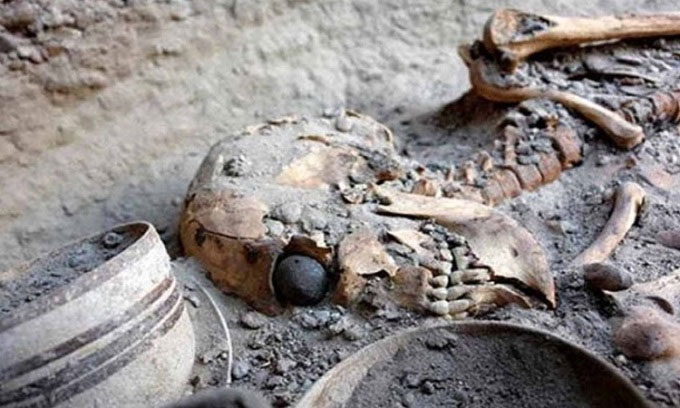World's oldest fake eye discovered
The prosthetic eye discovered in Iran was born around 2900 - 2800 BC and is still located in the eye socket of a woman's skull.
The discovery of the eye reveals the history of prosthetics including eyes, legs and arms. The way the eye is made also reflects the primitive conceptions of light, vision, and the purpose of prosthetics in ancient times. Prosthetic eyes have been around for thousands of years. Not only does it improve the patient's appearance, the prosthetic eye also prevents tissue in the eye socket from overgrowing and prevents foreign objects from entering the eye without a dressing.
Shahr-e Sukhteh is a Bronze Age urban site located in present-day southeastern Iran. The area has experienced several fires since about 3,200. Due to the age of artifacts discovered in the area, archaeologists believe that the city was abandoned in 2350 BC.

The false eye is located in the eye socket of the woman in the grave.
Various excavations have been carried out in the city since 1997. The prosthetic eye was taken from the remains of a woman estimated to be 1.8 meters tall. Evidence from the eye socket confirms the woman wore it all the time before her death instead of placing it in the grave after death. They estimate the woman was around 25-30 years old when she died.
Archaeologists who discovered the false eye say it was made from a mixture of natural tar and animal fat, likely to have kept it moist and durable during use 4,800 years ago. The team was very surprised by the craftsmanship of the maker. The capillary eye is painted with gold thread less than a millimeter thick. The circular pupil is etched anteriorly with parallel lines all around, forming the iris. Two eyelets on either side of the artificial eye reveal how to keep the eye in place. The soft gold wire prevents the eye from falling out, and helps the eye move slightly inside the socket. These details show that its creator is very knowledgeable about eye anatomy.
Eye studies show that women wear eyes during life because eyelid tissue is still attached to the eye. The scientists also found evidence of tissue around the skull. Woman with an abscess on her eyelid from rubbing against her prosthetic eye while blinking.
The archaeological team also found many clay pots, decorative beads and pieces of jewelry in the tomb of the ancient woman. In particular, a leather backpack and mirror are both in perfect condition. The finding led researchers to believe that the woman had a high social status and could be a member of the royal family. Only individuals with such important status possessed jewelry, pottery, leather, and bronze.
- Discover the world's oldest
- 14 oldest ancient artifacts in the world
- Hubble telescope detects the oldest galaxy
- The oldest dam discovered 10,000 years ago
- 10 oldest antiquities in the world
- Revealing the secrets of fake doors in the tomb of Pharaoh
- How to recognize fake beef with just one sheet of paper, everyone can do it
- 5 ways to identify standard fake plastic rice without correction
- Discover the oldest well in Europe
- The oldest telescope in the world
- Discover the oldest universe spiral galaxy
- The fake Trojan add-on Trojan is extremely dangerous
 Discovered an ancient centipede fossil 99 million years old
Discovered an ancient centipede fossil 99 million years old Discovered bat-like dinosaurs in China
Discovered bat-like dinosaurs in China Discovered a 200-year-old bronze cannon of the coast
Discovered a 200-year-old bronze cannon of the coast Discover 305 million-year-old spider fossils
Discover 305 million-year-old spider fossils